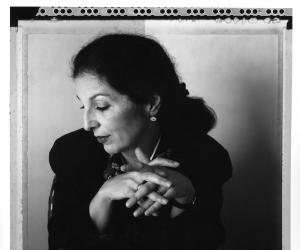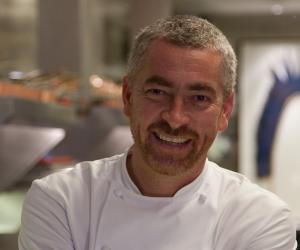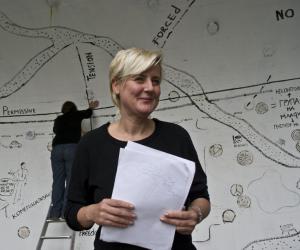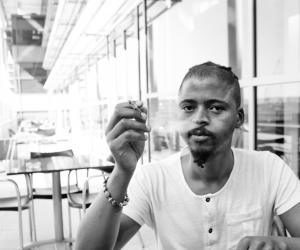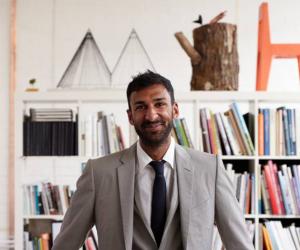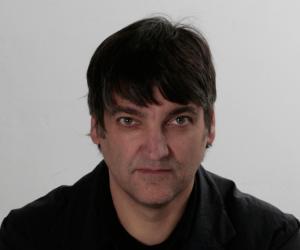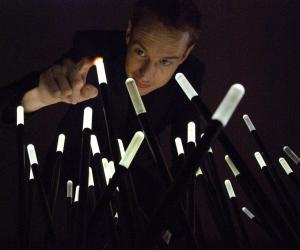The second day of Design Indaba Conference, on Thursday 28 February 2013, was a rollercoaster ride driven by world leaders in creative thought; tears were shed, minds were blown, some speakers elicited standing ovations, while others had the audience in stitches. Overall it was a highly successful conference day. Here are the highlights:
Steven Heller
First up was Steve Heller, the “Yoda of design”, as a journalist, critic, editor and author of over 150 books on design. He was also an art director at the New York Times for 33 years. Today Heller spoke about his collection of design objects of cultures of consumption, raising questions like, “What is the visual code that needs to be cracked to understand consumption?” Of his obsession he said, “I collect because... I am interested in how stylings can make consumers have an uncontrollable desire... I like to think of my collection as an archeological dig and I've discovered the remnants of commercial culture.” His fascination with, and interrogation of, commercial culture has driven a long and successful career. As Heller put it, “hopefully that will have an impact on people”. It certainly has.
Louise Fili
Fili and Heller are the second “power couple” (as MC Michael Bierut termed it) on the programme this year, with Fili being a graphic designer who has designed almost 2 000 book jackets in her career, and since then become a global leader in food packaging design. An Italian from New Jersey she felt a kinship to Italian design, and said "Because I couldn't live [in Italy] I had to learn to make my own typographic oasis in New York". And Fili has done just that. Commenting on the field, Fili said, “One of my packaging designs was for seven cents of salt that sold for $12... what does that say about packaging design?” Yes, it says a lot.
Jeanne van Heeswijk
“Agent of social change” Jeanne van Heeswijk was a pertinent addition to the lineup due to the very topical nature of her work. A crucial element in design today is the cityscape – many of our vexing issues relate back to the urban experience – and Van Heeswijk deals with this head on. While it’s important to develop schemes for urban upgrade, at the same time, Van Heeswijk points out, “If you think about a creative city, what does that mean for the people who are living there?” Don’t throw the baby out with the bath water, she’s saying. Work with what you’ve got. We should be asking, “What are the skills in the area, and why don't we see them taking part in the cityscape?” because “sharing expertise will build a community.” She’s all about doing and doing again, not just saying, and challenged the audience: “Don't wait for a future, create your own future. Make local qualities emergent and re-root them communally.” Everyone is sold.
Alex Atala
South America’s number-one chef Alex Atala was a crowd favourite for his warm, Brazilian charm and unabated passion for nature’s bounty. His intricate dishes are plated with the accurate precision of tweezers, like miniature works of art, using natural, but often surprising ingredients, like charcoal, ants or carbonated herbs. “The best way to be global is to be local," he said. “It's so simple” – making use of your local, natural ingredients and flavours to do something original and special. He also posed the question “What is creativity?” and said, “Put all your pre-conceptions aside. It’s not something that hasn’t been done before. It’s something you do that surprises you. Something you know, that you don't know you know.” Given his reputation, it seems he is onto something.
Nicholas Hlobo (supported by Kesivan Naidoo & Reza Khota)
South African artist Nicholas Hlobo descended onto the stage in a white fabric cocoon, to the deep sounds of a reverberant chant. The singing is accompanied by Kesivan Naidoo on drums and Reza Khota on guitar. A slideshow of Hlobo’s work and back story – reflecting on his Xhosa upbringing – forms a narrative, with Hlobo’s on-screen notes communicating the verbal part of this presentation. As he exits the cocoon you see that it is in fact Hlobo who is singing, and he continues to do so for the course of the 40-minute lecture. He doesn’t speak to the audience, but his chant and the captions on screen more than suffice to enrapture the audience. This writer is reminded of statement by Leanie van der Vver on the first day of the conference, about art being the more sophisticated form of communication, and is inclined to agree. Even when the next presentation begins there is still an awkward, eerie silence in the auditorium. No one knows what to say. His was the first standing ovation of the day. At that point, words weren't important.
Asif Khan
Asif Khan is an architect, if you can call him that, who challenges convention and uses experimental materials. “If you begin with a conventional framework,” he says, “then the things you build are only the things that you can imagine.” And so he turns architecture into music, or asks questions like "If you combine bubble bath with helium gas you can create clouds... why can't architecture be lightweight, like clouds?" – and he finds out. His work is pretty conceptual, often defying reason for the sake of innovation. “It's not really about the object's usability,” he says. “It's about its mental space.” And it seems like a good head space to be in, because useful or not, his work is fascinating.
Martí Guixé
This was the funniest presentation of the week thus far – curated as such, for, as it turns out, Guixé does do serious work too. He presented projects like a fog made from gin and tonic, a car window that allows you to watch yourself driving, a public fountain champagne bar, and a retail store décor system that involves spending the budget on booze and throwing a paint party – something that yields a different result each time depending on the nature of the party, and which has turned out to be a great success. This quirky Catalan designer (not Spanish, he points out) says he’s an ex-designer: he “removes all the bad stuff” and uses what’s left (translated as his implicit disregard for the limitations implied by the discipline). His was a well-timed, thoroughly enjoyable presentation that lifted the spirits in the room. Until then, the day had become quite serious.
Daan Roosegaarde
Another high point of the day, Daan Roosegaarde spoke about “the future of design” through his work, which he likes to call “techno-poetry”. Using technology in ways that make objects behave as if they’re autonomously interacting with humans, Roosegaarde seeks to create a new kind of reality, one in which we engage with things and each other on completely new levels. Beyond the philosophical he presented some pertinent real-world applications of his techno-poetry too: a dancefloor that generates energy by being danced on; glow-in-the-dark road paint that charges by day and glows at night, reducing the need for streetlights; heat-sensitive paint that could, for example, produce a snowflake pattern on the road to warn drivers of dangerous conditions. And a few cheekier ones too – like a dress that becomes transparent when the wearer is turned on, or a chair that zaps people (annoying clients) with an electric shock when they say “Yes, but…”. This artist and innovator is certainly going places, and the audience’s enthusiastic ovation showed that they certainly agree.


















